Indianapolis Motor Speedway Museum
 Indianapolis Motor Speedway Museum | |
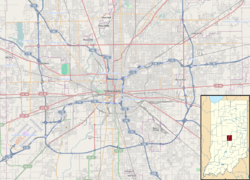 Location in Indianapolis | |
| Established | 1975 |
|---|---|
| Location |
4790 West 16th Street Speedway, Indiana 46222 |
| Coordinates | 39°47′25″N 86°14′01″W / 39.790298°N 86.233597°W |
| Type | Automotive |
| Website | Official website |
The Indianapolis Motor Speedway Museum is an automotive museum on the grounds of the Indianapolis Motor Speedway in Speedway, Indiana, United States, which houses the Auto Racing Hall of Fame.[1] It is intrinsically linked to the Indianapolis 500 and Brickyard 400, but it also includes exhibits reflecting other forms of motorsports, passenger cars, and general automotive history. In 2006, it celebrated its 50th anniversary. The museum foundation possesses several former Indianapolis 500-winning cars, and they are regularly rotated onto the display floor exhibits.
The museum is independently owned and operated by the Indianapolis Motor Speedway Foundation, Inc., a registered 501(c)(3) organization.[2] The museum dates back to 1956, and moved to the current building in 1976. It is located in the infield of the Indianapolis Motor Speedway race course, and is open year-round.
History
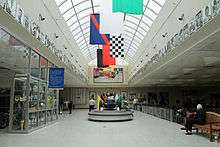
The first museum at the Indianapolis Motor Speedway was completed April 7, 1956[3][4][5] It was located on the southwest corner of the property, outside turn one of the famous oval, at the corner of 16th Street and Georgetown Road. Its exhibits included Ray Harroun's 1911 Indy 500 winning car, and a handful of other vehicles. Karl Kizer became the first curator.[3] When it opened, it only had six cars.[3] Within a number of years, dozens of collector cars were being donated and acquired. It did not take long for management to realize that the building was of insufficient size.[3][5] According to Speedway publicist Al Bloemker, by 1961, the museum was seeing an average of 5,000 visitors per week (not including month of May crowds).[6]
In 1975, the Indianapolis Motor Speedway broke ground on a new 96,000-square-foot (8,900 m2) museum and administration building, located in the infield of the track.[4] The two-story white building was made of Wyoming quartz, and along with the museum, housed office space, the ticket office, a gift shop, and photography department. It officially opened to the public on April 5, 1976,[3] coinciding with the year-long United States Bicentennial celebration.[4] It officially operated under the name Hall of Fame Museum, but was known colloquially as the Indianapolis Motor Speedway Hall of Fame Museum. The original museum building outside turn one was kept intact, and converted into additional office space.
The museum, representing the entire facility, was placed on the National Register of Historic Places in 1975 and designated a National Historic Landmark in 1987.[5]
In the summer of 1993, the original museum building outside of turn one was demolished. In its place a multi-million dollar administration building was erected.[7][8] The administrative and ticket offices were moved out of the infield museum building, and relocated to the new admin office. This freed up floor space in the museum for an expanded gift shop and other exhibits.
In 1993, the museum parking lot hosted the first "Indy 500 Expo" during race festivities, an outdoor interactive spectator exhibit. In 1995, it was expanded and renamed "Indy 500 FanFest". It was discontinued after 1997, but in recent years, smaller displays sponsored by Chevrolet have featured former pace cars and other exhibits.
In 2016, a revitalization and modernization project began, to expand the museum floor and add interactive displays. In addition, in April 2016, the facility was officially renamed the Indianapolis Motor Speedway Museum.
Exhibits
The museum rotates a display of over 75 cars at any given time.[3] Due to considerable space restraints, only a small portion of the total collection can be displayed.[5] Many cars are stored in the invitation-only basement, or at separate off-site facilities. Some of the cars in storage, however, are not restored to display condition. Frequently, cars are sent on loan for display at other museums, historical car shows, parades, and other activities.
The collection includes[3][4][5][9] over thirty Indianapolis 500 winning cars, various other Indy cars, and several racing cars from other disciplines. Other items on display include trophies, plaques, racing paraphernalia such as helmets, gloves, and driver's suits. A collection of models, photographs, toys, and paintings are also for view. One display exhibits a timeline of scoring devices.
Indy 500 winning cars

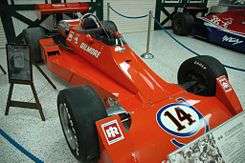
- 1911 Marmon Wasp (winner of first Indianapolis 500) (Ray Harroun)
- 1912 National (Joe Dawson)
- 1914 Delage (Rene Thomas)
- 1922 Duesenberg (also won 1921 French Grand Prix at Le Mans; painted in 1921 livery) (Jimmy Murphy)
- 1925/1927 Duesenberg (driven by Peter DePaolo in 1925, and by George Souders in 1927.)
- 1928 Miller (Louis Meyer)
- 1932 Miller-Hartz (Fred Frame)
- 1939-1940 Boyle Special Maserati (back-to-back winner) (driven both years by Wilbur Shaw.)
- 1941 Noc-Out Hose Clamp Special (Floyd Davis/Mauri Rose)
- 1946 Thorne Engineering (first race under Hulman ownership) (George Robson)
- 1947-1948 Blue Crown Spark Plug Special (back-to-back winner) (driven both years by Mauri Rose)
- 1950 Wynn's Offy (Johnnie Parsons)
- 1951 Belanger Special (Lee Wallard)
- 1953-1954 Fuel Injection Offy (back-to-back winner) (Bill Vukovich)
- 1955 John Zink Offy (Bob Sweikert)
- 1957-1958 Belond Special Offy (back-to-back winner) (Driven by Sam Hanks in 1957, and Jimmy Bryan in 1958)
- 1960 Ken Paul Special (replica) (Jim Rathmann)
- 1961 Bowes Seal Fast Offy (first of A. J. Foyt's four wins)
- 1962 Leader Card Watson Roadster (Rodger Ward)
- 1963 Agajanian Watson Offy (Old Calhoun) (Parnelli Jones)
- 1964 Sheraton-Thompson Watson Offy (second of A. J. Foyt's four wins)
- 1967 Sheraton-Thompson Coyote Foyt (third of A. J. Foyt's four wins)
- 1968 Rislone Special Eagle (Bobby Unser)
- 1969 STP Hawk Ford (replica)(Mario Andretti)
- 1972 Sunoco McLaren (Mark Donohue)
- 1973 STP Eagle Offy (replica, first win for Gordon Johncock)
- 1977 Gilmore Racing Team Coyote/Foyt (fourth of A. J. Foyt's four wins)
- 1978 First National City Traveler's Checks Lola/Cosworth (Al Unser, Sr.)
- 1980 Pennzoil Chapparal (Johnny Rutherford)
- 1982 STP Wildcat/Cosworth (Gordon Johncock)
- 1983 Texaco Star (Tom Sneva)
- 1988 Pennzoil Z-7 Special (Rick Mears; on temporary loan from Penske Racing in 2008)
- 1990 Domino's Pizza Hot One Lola/Chevrolet (Arie Luyendyk)
- 1995 Player's Ltd. Reynard/Ford Cosworth BX (Jacques Villeneuve)
- 1998 Rachel's Potato Chips Dallara/Aurora (Eddie Cheever)
- 1999 Powerteam Aurora (Kenny Bräck; on temporary loan from A. J. Foyt Enterprises)
Other Indy cars
- 1912 Fiat driven by Teddy Tetzlaff to second place
- 1925 Miller Junior Eight
- 1925 Miller Special
- 1931 Cummins Diesel driven by Dave Evans (first car to complete the Indianapolis 500 without a pit stop)
- 1935 Miller-Ford
- 1938 Bowes Seal Fast Special driven by Louis Meyer (flipped car during race, and retired)
- 1940 Sampson Special
- 1948 Alfa Romeo Tipo 308 driven by Johnny Mauro
- 1950 Cummins Diesel Special driven by Jimmy Jackson
- 1950 Russo-Nichels Special (won the open wheel race at Darlington by Paul Russo)[10]
- 1952 Ferrari Special
- 1954 Dean Van Lines Special (Jimmy Bryan; 2nd-place finisher)[10]
- 1956 Wolcott Special (driven by Len Sutton, and Rodger Ward at Darlington)[10]
- 1957 Dean Van Lines Special (winner of 1957 Race of Two Worlds)
- 1958 Leader Card Monza (winner of 1958 Race of Two Worlds)
- 1961 Cooper Climax driven by Jack Brabham, the first car of the European rear-engined revolution (the car in the museum is the back-up car a normal Cooper T53 Grand Prix car and not the T54 that Brabham drove).
- 1963 Lotus Powered by Ford driven by Jim Clark
- 1967 STP-Paxton Turbocar driven by Parnelli Jones (on loan from the Smithsonian Institution's National Museum of American History)
- 1976 Bryant Heating & Cooling Offy driven by Janet Guthrie during practice.
- 1977 Bryant Heating & Cooling Lightning/Offy driven by Janet Guthrie, the first female to qualify for the Indy 500.
- 1968 STP Wedge Lotus/Turbine
- 1995 Reynard/Ford Cosworth XB driven by Arie Luyendyk (set current IMS track record in 1996)
- 2005 Panoz/Honda driven by Danica Patrick, the first female driver to lead a lap during the Indianapolis 500
Passenger cars
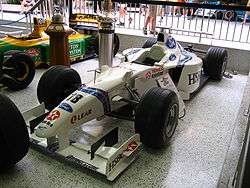


- At least one Indy 500 pace car from 1911, 1930, 1964, 1966, and 1975-2008.[11]
- 1886 Daimler "Motor Carriage"
- 1886 Benz Patent Motorwagen
- 1903 Premier
- 1903 Premier Special owned by Carl Fisher
- 1908 Richmond Surrey
- 1909 Haynes
- 1911 Cole 30
- 1914 Marmon roadster
- 1925 McFarlan TV6 passenger roadster.
- 1935 Duesenberg Model JN four-door convertible passenger car
Other race cars
- A NASCAR Winston Cup stock car driven and donated by Richard Petty in 1993.
- A sprint car driven by A. J. Foyt and George Snider
- 2007 Allstate 400 at the Brickyard winning car driven by Tony Stewart
- 1998 Stewart SF02-Ford Formula One car
- 1991 Benetton B191B-Ford Formula One car
- 1965 Le Mans-winning Ferrari 250 LM.
- 1964 Hussein 1/Dodge Zerex Special driven by A. J. Foyt
- 1961 Birdcage Maserati
- 1957 SSI Corvette
- 1954-55 Mercedes-Benz W196 Formula One car
- 1929 Bugatti 35-B
- 1907 Itala G.P. race car
- 1906 Laurin & Klement race car
- 1906 Renault Grand Prix
- Indy car used during the filming of Winning (not restored)
- 1965 Spirit of America - Sonic 1 Land Speed Record car
Trophies
- Permanent home for the Borg-Warner Trophy
- The Wheeler-Schebler Trophy, which pre-dates the Borg-Warner
- Permanent home for the PPG trophy, awarded to the winner of the Brickyard 400
- Historic Race of Two Worlds trophy
- Display case of historic trophies and medals from a broad range of racing events
Selected exhibits
- Indianapolis 500 picture wall including winner's portrait and car photograph of every Indianapolis 500 winner from 1911 to 2014
- Various paintings and photographs from noteworthy artists
- Speedway photography department, including over 4 million images
- Indianapolis Motor Speedway Radio Network exhibit, including antique radio equipment
- The Tony Hulman theatre, showing a short film about the history of the race
- An additional admission includes a bus tour of the track
- Louis Chevrolet Memorial
Basement
Due to the size of the collection, and space constraints on the display floor, a large portion of the collection is stored in the basement. Some cars are rotated into display, while others remain downstairs permanently, out of view from the public. The basement at the museum is strictly off-limits to the public, and admittance is by invitation only. The contents of the basement collection has become a source of folklore and mystique, as only a chosen few have been allowed to enter, and photography is not allowed.
North Wing
In 2016, the museum display floor was expanded by 6,000 square feet after office space was relocated to another building.[12] The new North Wing is used to display additional cars, and offers a view of a portion of the IMS road course.
Auto Racing Hall of Fame
The Indianapolis Motor Speedway Hall of Fame, also referred to as Auto Racing Hall of Fame,[1] dates back to 1952. It was established and supported by the AAA and Ford Foundation.[3] It was originally the brainchild of Tony Hulman[3] who had expressed interest in starting a racing hall of fame shortly after he purchased the Indianapolis Motor Speedway in 1946.[3] As of 2015, there have been 150 inductees enshrined into the hall.
The AAA dropped out of racing entirely in 1955. After being established for only three years, and after only a handful of historical, "veterans committee" inductees, the hall of fame went dormant. A year later, the first Indianapolis Motor Speedway museum opened its doors. In 1961, Hulman acquired and revived the hall of fame,[3] and incorporated it into the Speedway's museum organization.
Candidates can be nominated after at least twenty years from the first date of active participation in professional-level auto racing. A short list of eight finalists from before 1970, and eight after 1970 are placed on the ballot. Inductees must receive 75 percent of the votes of a roughly 150-member[1] panel of racing officials, living hall of fame members, and selected media representatives. Participation and accomplishments in the Indianapolis 500 are heavily weighed, but are not the lone factors in consideration. Voting is usually held annually in the spring, and members are inducted about a week before the race during a special ceremony. There is no set number of inductees for each year, and the number varies annually.
Inductees that are deceased are sometimes assigned Speedway historian Donald Davidson to accept the award in their memory. In 2004, former car owner Roger Penske accepted the award on behalf of Emerson Fittipaldi, who could not make the trip from Brazil. The current inductees are summarized below.[13]
The 2016 inductee was Paul Goldsmith.
Inductees - Drivers
- Fred Agabashian
- Johnny Aitken
- Gil Andersen
- Mario Andretti
- Michael Andretti
- Erwin "Cannon Ball" Baker
- Henry Banks
- Cliff Bergere
- Tony Bettenhausen
- Joe Boyer
- Jack Brabham
- David L. Bruce-Brown
- Jimmy Bryan
- Bob Burman
- Duane Carter, Sr.
- Gaston Chevrolet
- Louis Chevrolet
- Jim Clark
- Earl Cooper
- Bill Cummings
- Joe Dawson
- Ralph DePalma
- Pete DePaolo
- Mark Donohue
- Cliff Durant
- Harlan Fengler
- Emerson Fittipaldi
- Pat Flaherty
- A. J. Foyt
- Fred Frame
- Chip Ganassi
- Harry Grant
- Paul Goldsmith
- Jules Goux
- Dan Gurney
- Sam Hanks
- Ray Harroun
- Harry Hartz
- Eddie Hearne
- Ralph Hepburn
- Graham Hill
- Bill Holland
- Ted Horn
- Gordon Johncock
- Parnelli Jones
- Ray Keech
- Joe Leonard
- Frank Lockhart
- Arie Luyendyk
- Rex Mays
- Roger McCluskey
- Jim McElreath
- Jack McGrath
- Rick Mears
- Louis Meyer
- Chet Miller
- Tommy Milton
- Lou Moore
- Ralph Mulford
- Jimmy Murphy
- Duke Nalon
- Barney Oldfield
- Johnnie Parsons
- Bobby Rahal
- Jim Rathmann
- Dario Resta
- Eddie Rickenbacker
- Floyd Roberts
- Mauri Rose
- Lloyd Ruby
- Johnny Rutherford
- Troy Ruttman
- Eddie Sachs
- Wilbur Shaw
- Tom Sneva
- Jimmy Snyder
- Myron Stevens
- Jackie Stewart
- Lewis Strang
- Bob Sweikert
- Al Unser, Sr.
- Al Unser, Jr.
- Bobby Unser
- Bill Vukovich
- Lee Wallard
- Rodger Ward
- Howdy Wilcox
Inductees - Contributors
- J.C. Agajanian
- James A. Allison
- George Bignotti
- Thomas W. Binford
- Clint Brawner
- Clarence Cagle
- Phil Casey
- Tom Carnegie
- Colin Chapman
- J. Walter Christie
- Joe Cloutier
- Sid Collins
- Frank Coon
- Donald Davidson
- Al Dean
- Bert Dingley
- Dale Drake
- August Duesenberg
- Fred Duesenberg
- Chris Economaki
- Eddie Edenburn
- Quin Epperly
- Harvey S. Firestone, Sr.
- Carl Fisher
- Henry Ford
- Mari Hulman George
- Earl Gilmore
- Leo Goossen
- Andy Granatelli
- Jim Hall
- Harry C. "Cotton" Henning
- Takeo "Chickie" Hirashima
- Linsey Hopkins
- Mary Fendrich Hulman
- Tony Hulman
- Frank Kurtis
- Eddie Kuzma
- Jean Marcenac
- Jim McGee
- Leo Mehl
- Louis "Sonny" Meyer, Jr.[14]
- Harry Miller
- Theodore E. "Pop" Myers
- Fred Offenhauser
- Roger Penske
- Art Pillsbury
- Herb Porter
- Chester Ricker
- George Robertson
- George Salih
- Bill Simpson
- Art Sparks
- Harry C. Stutz
- Jim Travers
- William K. Vanderbilt
- Fred Wagner
- A. J. Watson
- Lew Welch
- Bob Wilke
- Ed Winfield
- Pat Vidan
- John Zink
Future
In 2007, the town of Speedway, Indiana unveiled a large redevolpment plan for the vicinity of the Indianapolis Motor Speedway.[15] Some plans have included a new larger Hall of Fame Museum, located outside the track to the south. No official plans have been announced.
Gallery
- Indiana state historical marker outside the IMS Hall of Fame Museum
- Trophy cabinet at the Hall of Fame Museum
- Racing cars at the Hall of Fame Museum
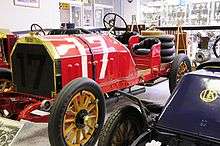 1907 Itala G.P. race car with 14.75 liter (900 cubic-inch) engine
1907 Itala G.P. race car with 14.75 liter (900 cubic-inch) engine
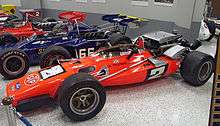 A replica of Mario Andretti's Brawner Hawk, the 1969 Indy 500 winner
A replica of Mario Andretti's Brawner Hawk, the 1969 Indy 500 winner Johnny Rutherford's 1980 pole and race-winning Chaparral 2K
Johnny Rutherford's 1980 pole and race-winning Chaparral 2K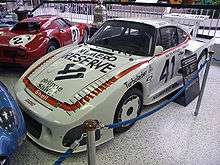 1979 Le Mans winning Porsche 935
1979 Le Mans winning Porsche 935- Terrazzo floor logo
- Race-worn helmet of 1986 Indianapolis 500 winner Bobby Rahal on display
See also
- List of automobile museums
- Louis Chevrolet Memorial that sits outside the museum.
References
- 1 2 3 Kelly, Paul (2010-04-28). "Davidson, Travers, Coon Comprise 2010 Class For Auto Racing Hall". IMS LLC. Retrieved 2010-04-29.
- ↑ Indianapolis Motor Speedway - Official Blog
- 1 2 3 4 5 6 7 8 9 10 11 ."1996 Indianapolis 500 Official Program". Indianapolis Motor Speedway. 1996-05-26.
- 1 2 3 4 "Hall of Fame Museum". IndianapolisMotorSpeedway.com. Retrieved 2008-03-31.
- 1 2 3 4 5 "Museum displays auto racing history". USAToday.com. 2007-05-07. Retrieved 2008-03-31.
- ↑ Fred Agabashian 1961 Interviews
- ↑ Smulevitz, Howard M. (June 29, 1993). "Speedway is adding new office building (Part 1)". The Indianapolis Star. p. 27. Retrieved October 13 – via Newspapers.com. Check date values in:
|access-date=(help)
- ↑ Smulevitz, Howard M. (June 29, 1993). "Speedway is adding new office building (Part 2)". The Indianapolis Star. p. 29. Retrieved October 13 – via Newspapers.com. Check date values in:
|access-date=(help)
- ↑ Davidson, Donald; Loscar, Mary Ellen; Bireley, Ellen; Shunck, Steve (2011), The Ultimate Indianapolis 500 Winning Car Collection, Indianapolis Motor Speedway Hall of Fame Museum: Weibel Design Inc. & Brad Hoffner Designs Inc.
- 1 2 3 "Indianapolis Motor Speedway Hall of Fame Museum Sends Three Cars to Darlington Historic Racing Festival". DarlingtonRaceway.com. 2009-07-20. Retrieved 2009-12-16.
- ↑ "Indy 500 Pace Car Reunion Bringing Classic Autos To IMS This Weekend". Indy500.com. 2006-05-18. Retrieved 2008-04-14.
- ↑ Speedway museum wants to double in size
- ↑ "2002 Record Book: Indianapolis 500". Indianapolis Star. 2002.
- ↑ Meyer, Leonard To Be Inducted Into Auto Racing Hall Of Fame
- ↑ "Speedway Redevelopment Commission". Speedway Redevelopment Commission. Retrieved 2008-03-31.
External links
| Wikimedia Commons has media related to Indianapolis Motor Speedway Hall of Fame Museum. |
- Hall of Fame Museum official website
- Speedway Redevelopment Commission